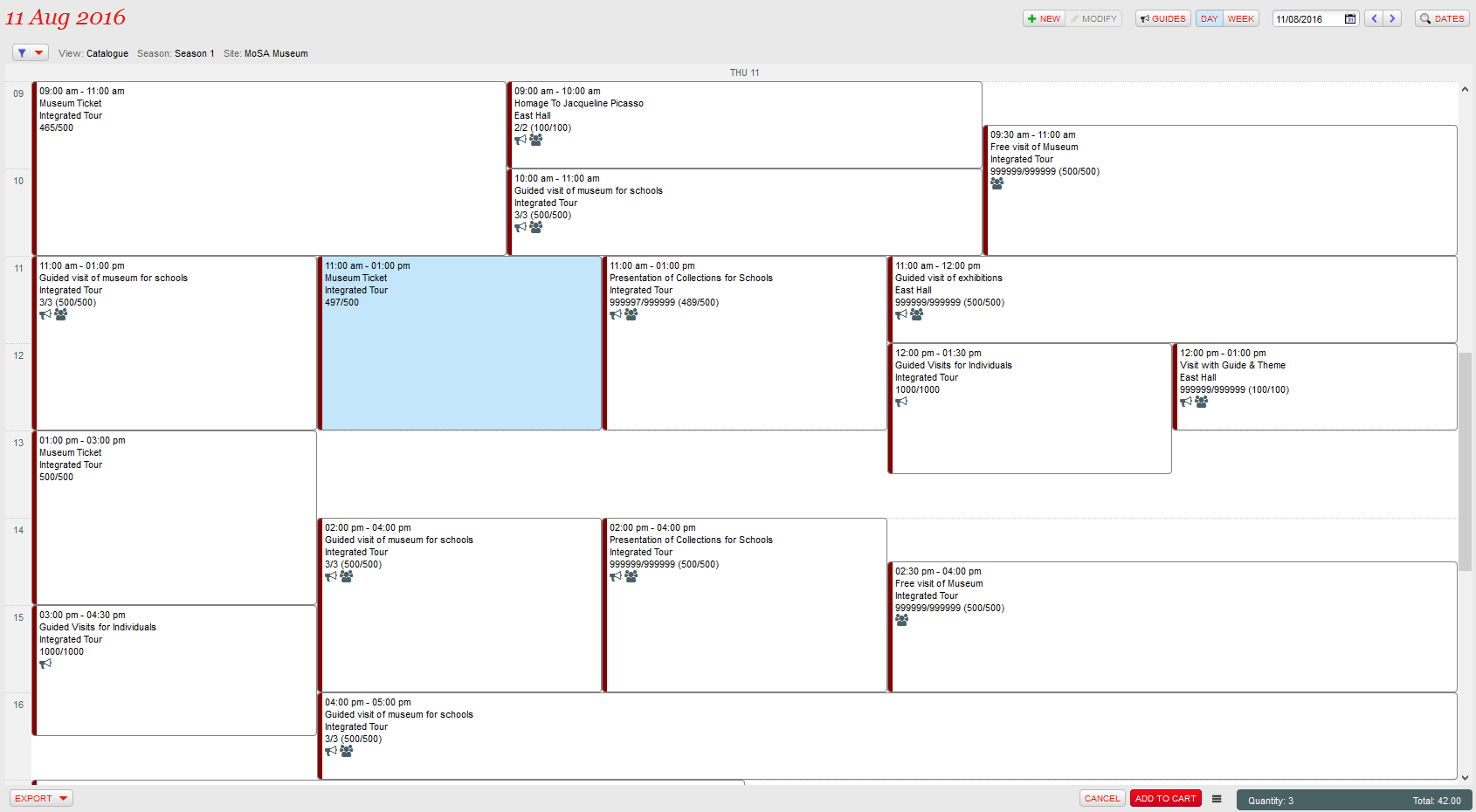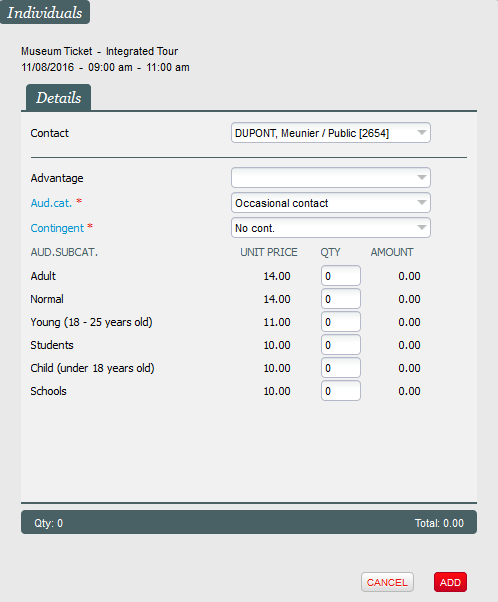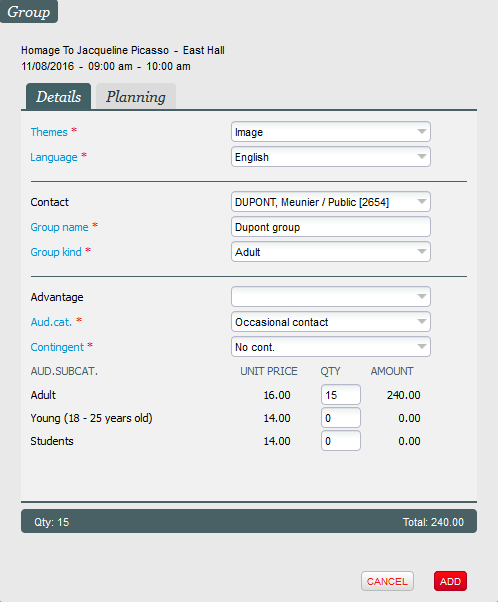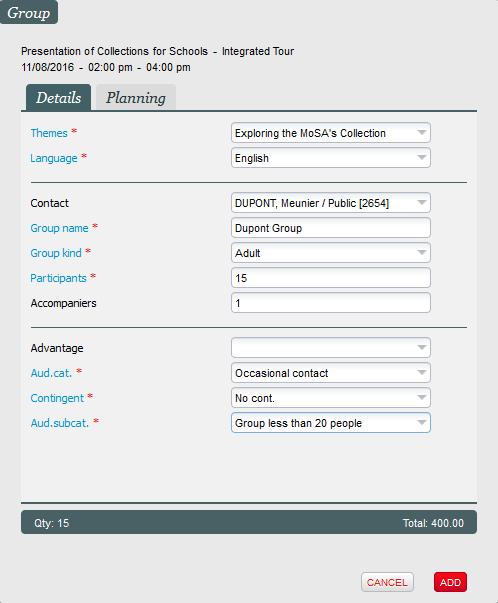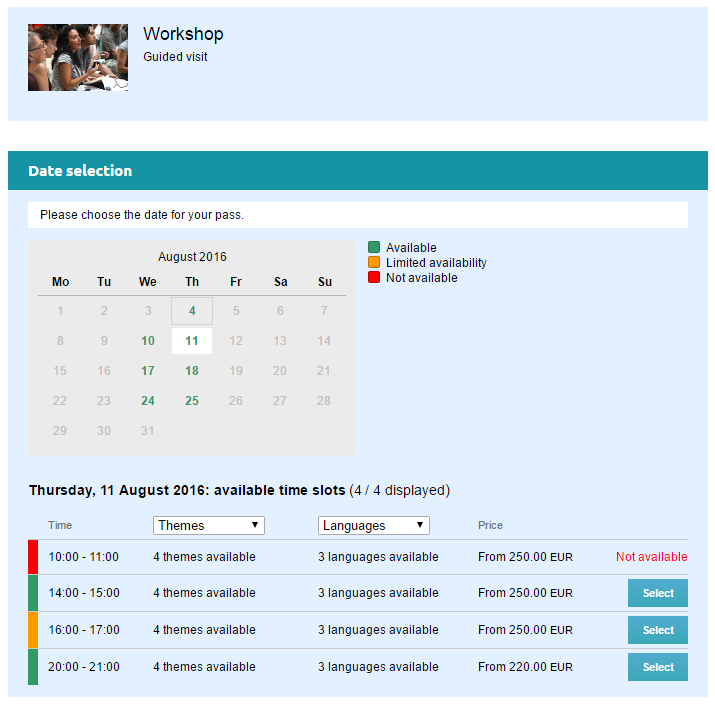Coexistence of old and new visits
While SecuTix previously offered the “Tour” product family, the new product family introduced in Matterhorn v2 offers many more functions while being easier to configure. We therefore advise customers to migrate to the new “Tour Pass” product family, for example at the start of the new season. In technical terms, the old and new ticket types can coexist without issue. However, we recommend keeping this period of coexistence to a minimum to avoid confusion.
Remember, the old product family was called “Visits” and the new product family is called “Visit pass”.
Do you offer individual or group visits? Do you want to simplify visit management? Do you want a sophisticated management tool that brings together guides, themes and language? Adapted to all situations, the new “Visit pass” product family responds to your needs, from the simplest to the most sophisticated.
The different types of Visit passes
The new Visit pass product family offers a full range of ticket types that will enhance your offer.
- Open or guided visit
- Individual or group visit
- For group visits
- An individual rate with one ticket per person
- A flat rate with a group ticket
These elements allow four different types of visits to be offered.
Here are some specific cases
- Open or non-guided visit: A group of friends decides to visit a museum. Some of them decide to take an audio guide, some don’t.
- Individual guided visit: A family of tourists participate in the 11 a.m. guided visit in English.
- Group visit with individual rate: A tour operator books a visit for a group of 25 people as part of an organized trip. Each participant receives their ticket in advance with the rest of their trip documents.
- Group visit with flat rate: A school group of 18 people (including followers) participates in a guided tour. They pay a flat rate for up to 20 people.
Configure your “tailor-made” visit
Visits can be configured in a number of ways:
- Minimum group size: When someone (for example a school representative) books a group visit for a class, a guide must be allocated to the class. A minimum group size can be imposed in order to use the available guides as effectively as possible.
- Maximum size for a start: To guarantee the best experience for visitors, you may need to limit the number of persons participating in a particular visit. For example, if there are more than 20 people, visitors may be unable to hear their guide’s comments or see the piece being discussed. That’s why SecuTix allows you to define a maximum size, for example 20 people. This limit does not affect the booking process, because a representative may nevertheless book a visit for a group of 35 people. In such cases, the system will automatically split the group in two "starts", with a guide required for each one. These two groups will do the visit at the same time, with separate guides.
- Maximum number of simultaneous starts: The number of visits taking place at the same time may need to be restricted depending on the guide availability and/or the layout of the premises. For example, it could be better to avoid having to group starts too close to each other or from passing each other during the visit.
- Tolerance for the maximum size of a start: This tolerance allows you to avoid creating an unnecessary visit group (and therefore using an extra guide) in borderline cases. For example, a group of 42 people wish to book a visit when the maximum size for a start is 20. By setting a tolerance of two people, you can allocate two visit starts, rather than the three that would normally be expected.
Several Visit passes may coexist in the same time slot, and you can define the maximum number of simultaneous starts in a time slot or by Visit pass type. If, for example, a maximum of five simultaneous starts is set, you can impose a maximum of three simultaneous “School Visit” Visit passes so that this type does not monopolize all of the available starts.
Choose the theme and language management that suits you
Several management modes are available:
- Manage the language and theme. This is the most common and is suited to cultural institutions that offer several themed visits that are each available in one or several languages.
- Do not manage the language or the visit theme. This choice is suited to non-guided visits, visits with audio guides and visits with a multilingual guide.
- Manage the language only. This choice is suited for guided visits relating to a single theme where explanations are provided in several languages, with each group of visitors receiving information in a single language.
You can also set theme and language restrictions by time slot. For example, you can decide that the German-speaking guide is not available on Tuesday mornings.
Enjoy a wealth of functions
Ticket office
The box-office provides the usual processes, such as bookings, sales, exchanges and cancellations, as well as sales as part of or through advantages. The careful attention paid to ergonomics means that the new product selection screen greatly facilitates the work of operators. A full-screen central calendar is displayed, allowing them to select Visit pass products.
A calendar is available for each type of Visit pass: individual, individual guided visit, individual rate groups and flat rate groups.
Using this calendar, operators can create time slots on the fly, check guides’ availability and consult visits that have already been planned. To give operators a coherent experience, the calendar’s ergonomics have also been considered to address needs relating to planning and welcoming visitors. Therefore, the Visit pass product selection screen and the new planning calendar have identical visuals and as many common functions as possible.
Vente en ligne
Nous avons conçu la vente en ligne des pass visites en pensant avant tout à l'utilisateur final. Ainsi l'ergonomie de sélection s'adapte à la volée en fonction du type de visite qu'a sélectionné l'internaute.
Les points clés sont:
- Un calendrier affichant les disponibilités globales chaque jour
- La liste des créneaux de chaque jour, avec les disponibilités de chacun, et la possibilité de filtrer par thème de visite et par langue de visite
- L'indication des quantités et des tarifs sur une deuxième page. Dans le cas de Pass visite pour les groupes, cette page permet également de renseigner les informations concernant le groupe (nom du groupe, nature du groupe - scolaire, association etc - et une éventuelle remarque).
Les fonctionnalités habituelles de SecuTix 360° sont compatibles, à savoir:
- La création d'un package à base de Pass visite. Toutefois les packages contenant un Pass visite de groupe à tarification forfaitaire ne sont pas supportés.
- La vente de Pass visite au moyen d'un avantage
- Le cross-selling classique. Le cross-selling conditionnel sera disponible ultérieurement.
Billets "groupe" et contrôle d'accès
Les Pass visite permettent l'utilisation d'un billet "groupe", c'est-à-dire qu'un seul billet est émis pour l'ensemble du groupe. Une quantité, ou taille de groupe, y est associée.
Lors du contrôle d'un billet "groupe", le nombre de personnes du groupe est affichée sur l'écran des appareils de contrôle d'accès Bluebirds (Android). Cette information est affichée à l'intérieur du cercle, que le résultat du contrôle soit OK, KO ou tarif réduit.
[picture]
Et les appareils sur Windows Mobile?
Les PDAs sur Windows Mobile n'ont pas été adaptés pour afficher cette information. Cependant, les scans sont effectués correctement et la capacité d'un groupe est disponible au niveau du reporting de la billetterie.
Les statistiques sur le nombre de visiteurs (différentes du nombre de billets scannés) seront disponibles:
- Dans le contrôle d'accès, lors de l'export de la liste des contrôles
- Dans le rapport "liste des billets" disponible depuis le menu "Gestion vente" > "rapports"
Vente tactile et borne
Les bornes ont été adaptées pour permettre la vente des visites individuelles. Les mêmes écrans actuellement utilisés pour l'achat d'une visite simple ont été repris pour ce nouveau type de produit.
[pictures]
Reporting
Les rapports de la billetterie et du contrôle d'accès ont été adaptés pour tenir compte des différents types de Pass visite. Ils fournissent par exemple des informations sur les groupes, les guides et les salles associées aux visites.

